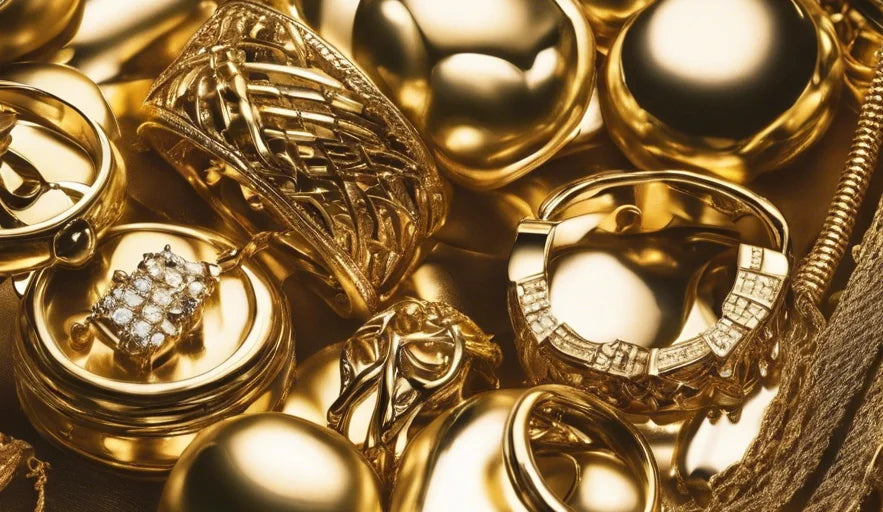
Reclaim Your Gold: Surprising Causes of Tarnishing
Share
Gold has long been celebrated for its beauty and luster, making it a popular choice for jewelry and decorative items. However, many people mistakenly believe that gold can tarnish like other metals such as silver. In reality, pure gold (24-karat) is highly resistant to tarnishing due to its exceptional chemical stability. This post delves into the reasons behind the tarnishing of gold alloys, the factors contributing to this phenomenon, and effective cleaning and maintenance techniques to keep your gold jewelry looking its best.
The Nature of Gold
Pure gold is an inert metal, meaning it doesn’t react easily with environmental elements. This lack of reactivity is why it doesn’t tarnish in the same way that metals like silver or copper do. However, gold is often alloyed with other metals to enhance its strength and durability, especially in jewelry. Common alloying metals include copper and silver, which can lead to tarnishing.
Gold jewelry typically comes in various karatages, such as 10K, 14K, or 18K, which indicate the proportion of gold in the alloy. The higher the karat, the more gold content and the lower the chances of tarnishing. For example, 24K gold is nearly pure, while 10K gold contains only about 42% gold, making it more susceptible to tarnishing.
What Causes Gold Alloys to Tarnish?
Tarnishing occurs in gold alloys primarily due to the presence of these additional metals. When exposed to air, moisture, and certain chemicals, these metals can oxidize or react, resulting in discoloration. Here are some key factors that contribute to the tarnishing of gold jewelry:
-
Exposure to Sweat: The natural oils and sweat from our skin can react with the metals in gold alloys, causing tarnish over time. This is particularly noticeable in rings and bracelets that are frequently in contact with skin.
-
Chemicals: Lotions, perfumes, and other personal care products can contain chemicals that may lead to tarnishing. Ingredients like alcohol, sulfur, and various fragrances can accelerate the tarnishing process.
-
Environmental Pollutants: Airborne pollutants can also contribute to the tarnishing process, especially in urban areas with higher levels of pollution. Acidic rain and dust can cause damage to the surface of gold jewelry over time.
-
Humidity: High humidity levels can facilitate the reaction between moisture and the metals in the gold alloy, leading to faster tarnishing.
How to Restore Tarnished Gold Jewelry
If your gold jewelry has tarnished, there’s no need to panic. Here are some effective methods to restore its shine:
-
Gentle Cleaning:
- Mix a few drops of mild dish soap with warm water in a bowl.
- Use a soft cloth or a soft-bristle toothbrush to gently clean the jewelry, focusing on tarnished areas. Avoid using abrasive materials that can scratch the surface.
- Rinse thoroughly with clean water and pat dry with a soft cloth.
-
Baking Soda Paste:
- Create a paste by mixing baking soda with a small amount of water. The paste should have a thick consistency.
- Apply the paste to the tarnished areas using a soft cloth, gently rubbing to remove tarnish. This works well due to baking soda's mild abrasive properties.
- Rinse the jewelry thoroughly with clean water to ensure no residue remains.
-
Commercial Cleaners:
- There are numerous jewelry cleaners specifically formulated for gold. Always follow the manufacturer’s instructions for the best results, and make sure the product is safe for your specific type of gold alloy.
-
Professional Cleaning:
- If the tarnish persists or your jewelry has intricate designs that require special care, consider taking it to a professional jeweler for cleaning. They have the tools and expertise to restore your jewelry without causing damage.
Preventing Future Tarnishing
Regular maintenance and proper care can significantly reduce the chances of tarnishing. Here are some tips to keep your gold jewelry in pristine condition:
-
Storage: Store your jewelry in a dry, cool place, ideally in a jewelry box or wrapped in a soft cloth to prevent exposure to air and moisture. You might also consider using anti-tarnish pouches or cloths.
-
Avoid Harsh Chemicals: Be cautious around chemicals found in household cleaners, swimming pools, and personal care products. It's best to remove your jewelry before swimming, exercising, or applying lotions and perfumes.
-
Regular Cleaning: Make a habit of cleaning your jewelry regularly to remove any build-up of oils or dirt that could lead to tarnishing. This can be as simple as wiping down your pieces after wearing them.
-
Limit Exposure: Try to limit your jewelry's exposure to environments that may accelerate tarnishing. For example, avoid wearing gold jewelry while exercising or doing household chores.
Conclusion
While gold itself does not tarnish, gold alloys can exhibit discoloration due to the presence of other metals and environmental factors. Understanding these nuances can help you care for your gold jewelry effectively, ensuring it remains a beautiful part of your collection for years to come. With regular cleaning and proper storage, you can enjoy the lasting beauty of gold without worrying about tarnish. By being proactive in your care routine, you'll keep your cherished pieces looking their absolute best.
